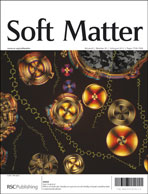Responses of preosteoblasts on nano-structured polymer surfaces prepared from block copolymer–surfactant complexes
Abstract
The surface nanotopography of polymer scaffolds is one of the most critical factors affecting cell phenotype and function in tissue engineering applications. We hypothesized that controlling the surface structure of polymer matrices on the nanometer size scale could be critical in the regulation of preosteoblast phenotypes. Nano-structured polymer surfaces on the sub-100 nanometer scale were produced via the self-assembly of polystyrene-b-poly(ethylene oxide)/dodecylbenzenesulfonic acid complex systems, and their structures were controlled by varying the composition and molecular weight of the copolymers and/or the surfactant concentration. Changes in PS domain sizes under 100 nm, which was considered the cell adhesion domain, strongly influenced the adhesion and proliferation of pre-osteoblasts cultured on the nano-patterned surfaces. The growth rate of the cells decreased as the PS domain size increased when the center-to-center distance between the domains was kept constant. In addition, osteoblastic differentiation was enhanced when cells were cultured on the surface containing larger adhesion domains. This approach to controlling the nano-structure of polymer surfaces may be useful in the design and tailoring of polymer scaffolds in tissue engineering applications.


 Please wait while we load your content...
Please wait while we load your content...